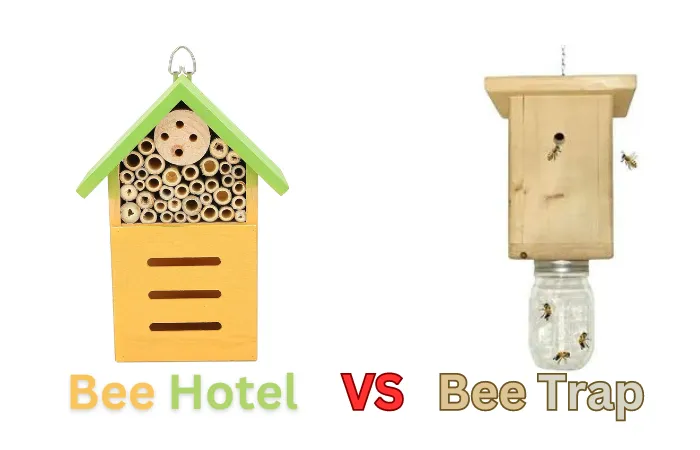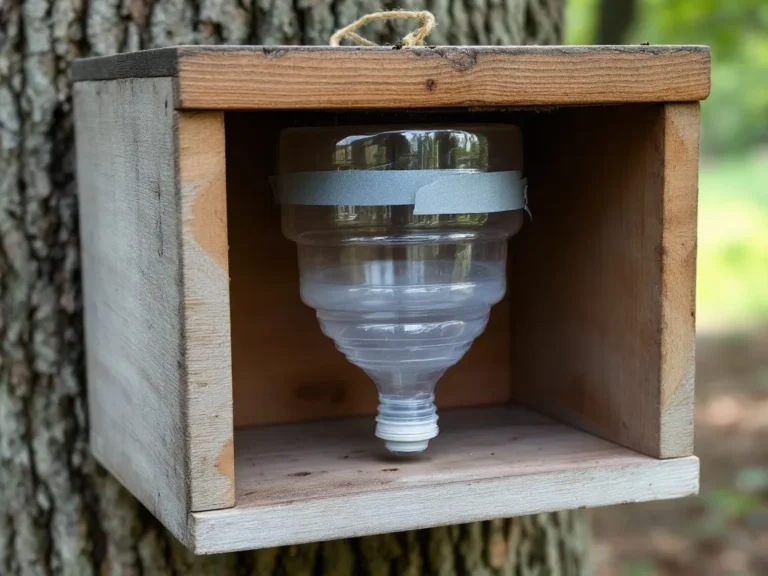When it comes to managing bees around your property, the terms “bee trap” and “bee hotel” might sound similar, but they serve very different purposes. While both are tools that involve bees, one is designed to control pests, and the other to support beneficial pollinators. Understanding the differences and similarities between a bee trap and a bee hotel can help you choose the right approach for your needs. In this article, we’ll explore what sets these two apart and when you should use each.
What is a Bee Trap?
- Purpose of a Bee Trap
- Pest Control: A bee trap is primarily used to capture and reduce the population of nuisance bees, like carpenter bees, which can cause damage to wooden structures.
- Types of Bee Traps: Explore different types of bee traps, such as those specifically designed for carpenter bees or wasps.
- How Bee Traps Work
- Luring and Capturing: Bee traps attract bees using bait or a pheromone, leading them into a chamber where they can’t escape.
- Placement and Usage: Discuss the best locations for placing bee traps, such as near eaves or wooden structures, to maximize effectiveness.
What is a Bee Hotel?
- Purpose of a Bee Hotel
- Supporting Pollinators: A bee hotel is a structure designed to provide a safe nesting site for solitary bees, which are important pollinators.
- Encouraging Biodiversity: Bee hotels help support local ecosystems by offering a habitat for bees that don’t live in hives.
- How Bee Hotels Work
- Providing Shelter: Bee hotels are filled with materials like bamboo tubes or drilled wood blocks, offering a variety of nesting options.
- Placement and Care: Discuss how to position a bee hotel in your garden and how to maintain it to attract solitary bees.
Similarities Between Bee Traps and Bee Hotels
- Involvement with Bees
- Bee-Focused Tools: Both bee traps and bee hotels are tools that involve managing or supporting bee populations.
- Wood as a Key Material
- Wooden Construction: Many bee traps and bee hotels are made from wood, making them blend into natural environments.
- Outdoor Installation
- Placed Outside: Both are installed outdoors, though their locations may differ based on their purpose.
Key Differences Between Bee Traps and Bee Hotels
- Purpose and Intent
- Trap vs. Habitat: The fundamental difference lies in their purpose; bee traps are for pest control, while bee hotels are for conservation and support of beneficial species.
- Impact on Bees
- Capturing vs. Sheltering: Bee traps can lead to the death of the bees, whereas bee hotels are designed to protect and support the bee population.
- Types of Bees Targeted
- Pests vs. Pollinators: Bee traps usually target nuisance species like carpenter bees, while bee hotels attract solitary, non-aggressive pollinators like mason bees.
When to Use a Bee Trap vs. a Bee Hotel
- Choosing the Right Tool
- Home Protection: If you’re dealing with carpenter bees causing damage to your home, a bee trap may be necessary.
- Supporting Pollinators: If you’re interested in promoting biodiversity and supporting the local bee population, installing a bee hotel is the way to go.
- Environmental Considerations
- Balancing Control and Conservation: Discuss how to balance the need for pest control with the importance of supporting pollinators.
Conclusion
Understanding the similarities and differences between bee traps and bee hotels is crucial for making informed decisions about managing bees around your property. Whether you’re looking to protect your home from carpenter bees or support the local bee population, knowing when to use each tool will help you achieve your goals effectively. By choosing the right approach, you can create a safer, more sustainable environment for both yourself and the bees.
Resources
- Bee Conservation Organizations: Xerces Society
- Pest Control Products: DoMyOwn
- Gardening for Pollinators: Royal Horticultural Society
FAQs
- Can I use a bee trap and a bee hotel at the same time?
- Yes, but place them in different areas to avoid attracting bees to the trap that you want to protect.
- Do bee hotels attract carpenter bees?
- No, bee hotels are typically designed for solitary pollinators like mason bees, not carpenter bees.
- Are bee traps harmful to the environment?
- Bee traps can reduce populations of nuisance bees but should be used judiciously to avoid negatively impacting local ecosystems.
- How can I maintain a bee hotel?
- Regularly clean the bee hotel and replace nesting materials as needed to ensure a healthy environment for the bees.
- What’s the best time of year to install a bee hotel?
- Spring is ideal for installing a bee hotel, as it aligns with the active nesting season of many solitary bees.





